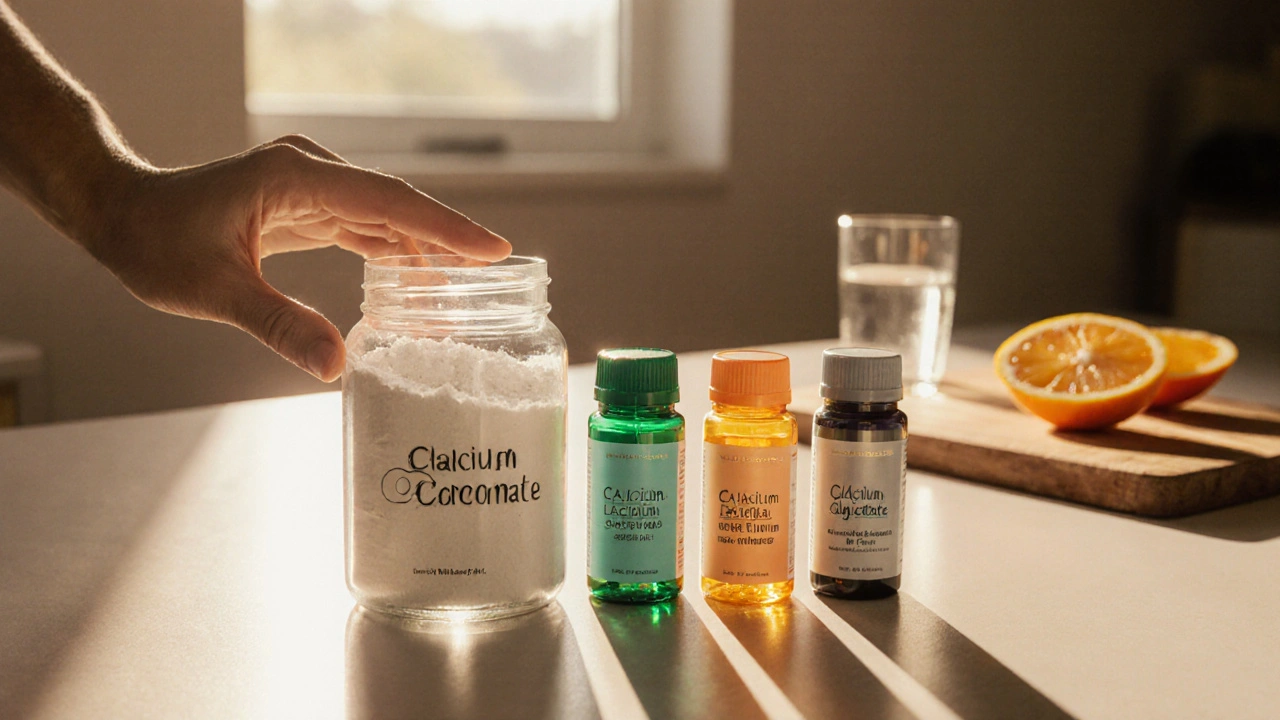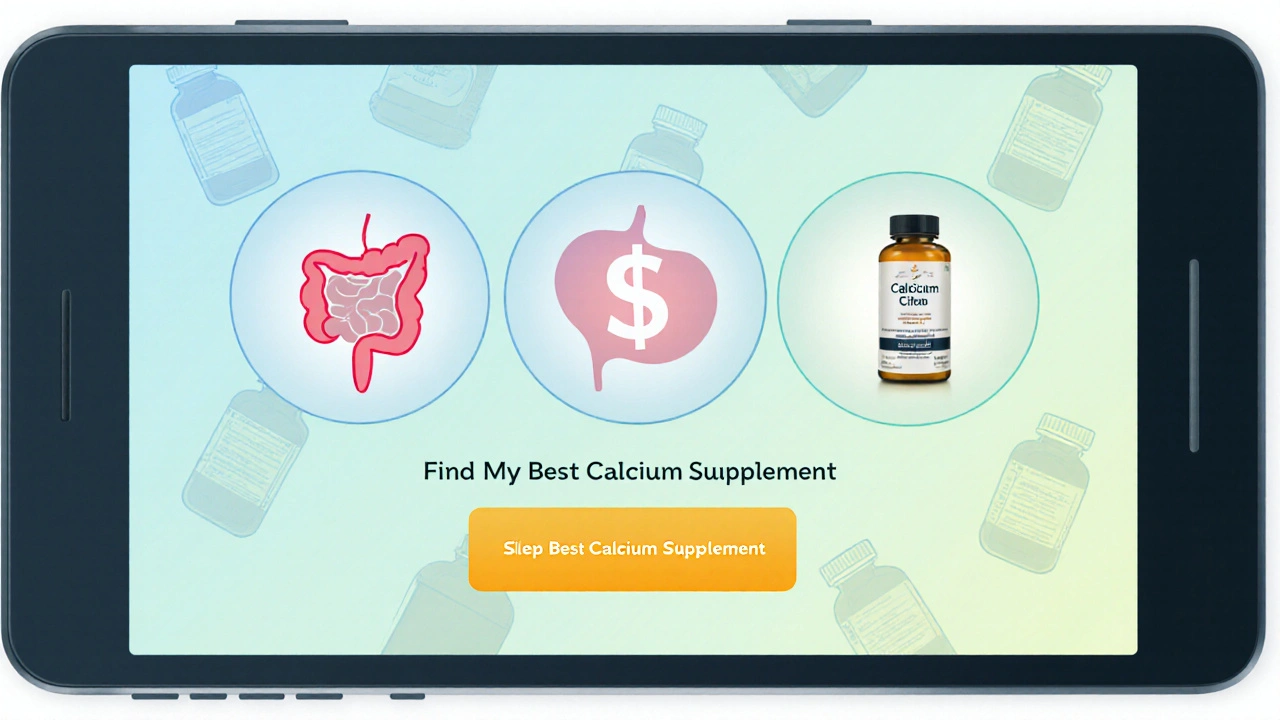Calcium Carbonate vs Other Calcium Supplements: Pros, Cons, and Best Choices

Calcium Supplement Selector
Select Your Conditions
Answer these questions to find the best calcium supplement for your needs.
Recommended Supplement
| Form | Elemental Calcium % | Best Taken With | Typical Cost (AU$/30 doses) | Digestive Tolerance | Ideal User |
|---|---|---|---|---|---|
| Calcium Carbonate | ≈40% | Meal (acidic environment) | ≈$6 | May cause gas/constipation | Budget-conscious adults without acid-reduction meds |
| Calcium Citrate | ≈21% | Any time (fasted ok) | ≈$9 | Gentle, low GI upset | Seniors, PPI users, sensitive stomachs |
| Calcium Lactate | ≈13% | Any time | ≈$8 | Very mild | Children, low-dose needs |
| Calcium Gluconate | ≈9% | Any time | ≈$10 | Excellent tolerance | Patients needing minimal calcium, post-surgery |
| Magnesium-Calcium Chelate | ≈15% (Ca) + 10% (Mg) | Meal or snack | ≈$12 | Good, plus less constipation | People seeking combined bone-muscle support |
Trying to pick the right calcium supplement can feel like navigating a maze of powders, pills, and promises. Most people start with the cheapest option-usually calcium carbonate-but the market is packed with alternatives that claim better absorption, fewer stomach aches, or added health benefits. This guide breaks down the chemistry, cost, and real‑world performance of calcium carbonate and its top rivals so you can decide which one actually fits your lifestyle and bone‑health goals.
Quick Take
- Calcium carbonate offers the highest elemental calcium (≈40%) and is cheapest, but needs food for best absorption.
- Calcium citrate is the most absorbable on an empty stomach and gentler on the gut, though it costs about 30‑50% more.
- Calcium lactate and calcium gluconate contain less calcium per dose, making them useful for children or those needing low‑dose supplementation.
- Magnesium‑calcium chelates add magnesium for bone health and reduce constipation, but price is higher.
- Pair any calcium source with vitamin D3 for optimal bone mineralization.
What Is Calcium Carbonate?
Calcium Carbonate is a mineral compound comprising about 40% elemental calcium, commonly sourced from limestone or oyster shells. Because of its high calcium density, manufacturers can pack a full daily dose into a single tablet, keeping prices low. However, its absorption hinges on stomach acid, so taking it with meals is crucial. In clinical studies, calcium carbonate delivered comparable bone‑density improvements to other forms when paired with adequate vitamin D, but it also showed a higher incidence of gas and constipation in sensitive individuals.
Alternative Calcium Forms
Below are the most widely used alternatives, each with its own set of attributes that may matter depending on your diet, medications, or digestive comfort.
Calcium Citrate is a calcium salt of citric acid that provides about 21% elemental calcium and absorbs well without food. Its gentle profile makes it a favorite for seniors and people on proton‑pump inhibitors, who often have reduced stomach acid.
Calcium Lactate is derived from lactic acid, offering roughly 13% elemental calcium and a pleasant, mildly acidic taste. It's frequently used in chewable tablets for children.
Calcium Gluconate is a water‑soluble calcium salt with only about 9% elemental calcium, often administered intravenously in hospitals. Oral versions are limited to low‑dose supplements for people who cannot tolerate higher calcium loads.
Magnesium‑Calcium Chelate is a compound that binds calcium and magnesium together, delivering roughly 15% elemental calcium plus 10% elemental magnesium. The added magnesium can improve muscle function and reduce constipation.
Vitamin D3 is cholecalciferol, the hormone‑like vitamin that boosts intestinal calcium absorption. Without sufficient vitamin D, even the most absorbable calcium form falls short of supporting bone health.
Osteoporosis is a skeletal disorder characterized by reduced bone mass and increased fracture risk. Calcium supplements are most beneficial when paired with weight‑bearing exercise and adequate vitamin D.

Head‑to‑Head Comparison
| Form | Elemental Calcium % | Best Taken With | Typical Cost (AU$/30doses) | Digestive Tolerance | Ideal User |
|---|---|---|---|---|---|
| Calcium Carbonate | ≈40% | Meal (acidic environment) | ≈$6 | May cause gas/constipation | Budget‑conscious adults without acid‑reduction meds |
| Calcium Citrate | ≈21% | Any time (fasted ok) | ≈$9 | Gentle, low GI upset | Seniors, PPI users, sensitive stomachs |
| Calcium Lactate | ≈13% | Any time | ≈$8 | Very mild | Children, low‑dose needs |
| Calcium Gluconate | ≈9% | Any time | ≈$10 | Excellent tolerance | Patients needing minimal calcium, post‑surgery |
| Magnesium‑Calcium Chelate | ≈15% (Ca) + 10% (Mg) | Meal or snack | ≈$12 | Good, plus less constipation | People seeking combined bone‑muscle support |
How to Choose the Right Calcium Supplement
Start by answering three quick questions:
- Do you regularly take acid‑reducing medication (e.g., omeprazole) or have low stomach acid? If yes, steer toward calcium citrate or a chelated form.
- Is cost a major factor? Calcium carbonate provides the most elemental calcium per dollar.
- Do you experience digestive discomfort with calcium tablets? If you notice gas, consider a lower‑dose lactate, gluconate, or a magnesium‑calcium blend.
Next, verify your vitamin D status. A simple blood test for 25‑hydroxy‑vitamin D can tell you whether you need supplemental vitamin D3 alongside calcium. Most adults benefit from 800-1000IU/day, but higher doses may be needed in winter months or for people with limited sun exposure.
Finally, think about dosage frequency. Calcium carbonate usually requires 2-3 tablets per day to hit the 1000‑1200mg target, while calcium citrate’s higher absorption means you can often get away with a single 500‑mg tablet.
Practical Tips for Maximizing Absorption
- Take calcium (any form) with a meal that contains some fat; dietary fat boosts vitamin D absorption, which in turn helps calcium uptake.
- Avoid taking calcium at the same time as iron or high‑dose zinc supplements-these minerals compete for absorption.
- If you split your dose, space doses at least four hours apart to keep serum calcium levels steady.
- Stay hydrated. Adequate water helps dissolve calcium salts and reduces the risk of kidney stone formation.
- Combine with weight‑bearing exercise (e.g., walking, resistance training) to stimulate bone formation.
Potential Pitfalls and Safety Concerns
Over‑supplementation can lead to hypercalcemia, which may cause nausea, frequent urination, and in severe cases, cardiac arrhythmias. Most cases arise from taking multiple calcium‑rich products simultaneously (e.g., multivitamins plus separate calcium tablets). Keep total daily elemental calcium under 2000mg unless a doctor advises otherwise.
Kidney stone risk rises slightly with high calcium‑carbonate intake, especially in people who already have a history of oxalate stones. In such cases, calcium citrate-because it binds oxalate in the gut-may actually lower stone formation risk.
Pregnant or breastfeeding women should consult their physician before starting any supplement, as calcium needs increase but excessive doses can affect fetal calcium balance.

Frequently Asked Questions
Is calcium carbonate effective for bone health?
Yes, when taken with adequate vitamin D and food, calcium carbonate delivers enough elemental calcium to support bone density, especially in people without acid‑reduction medication.
Should I choose calcium citrate if I have a sensitive stomach?
Calcium citrate is the better choice for sensitive stomachs because it absorbs well on an empty stomach and rarely causes gas or constipation.
How much vitamin D do I need with calcium supplements?
Most adults benefit from 800-1000IU of vitamin D3 daily; people with limited sun exposure or older adults may need up to 2000IU. A blood test can fine‑tune the dose.
Can calcium supplements cause kidney stones?
High doses of calcium carbonate can increase stone risk in prone individuals. Calcium citrate may actually reduce stone formation by binding dietary oxalate.
Is a magnesium‑calcium blend worth the extra cost?
If you experience constipation or want extra muscle support, the magnesium component can be beneficial, making the higher price justified for many active adults.

Whoa, the calcium showdown is like picking a champion in a video‑game arena! If you’re hunting for bang‑for‑buck, calcium carbonate swoops in with its 40% elemental punch and the price tag of a cup of coffee. But remember, it loves a hearty meal – the acid in your stomach is its secret weapon for absorption. On the flip side, calcium citrate plays nice on an empty stomach and won’t leave you feeling constipated, making it the go‑to for seniors and anyone on PPIs. Bottom line: match the form to your gut vibe and wallet, and you’ll keep those bones happy.
Great breakdown! 👍
Choosing a calcium supplement is far more nuanced than simply eyeballing the price tag, and the chemistry behind each form tells a detailed story about how our bodies will actually use the mineral. Calcium carbonate, with its impressive ~40% elemental calcium, indeed offers the highest calcium density per pill, but its reliance on gastric acid means that anyone on proton‑pump inhibitors or with hypochlorhydria may see suboptimal absorption, leading to the inevitable trade‑off of gastrointestinal upset. Calcium citrate, on the other hand, provides about 21% elemental calcium and shines precisely because it can be absorbed in both fed and fasted states, making it a reliable choice for older adults and those on acid‑reducing meds. The lower‑density forms like calcium lactate and calcium gluconate have niche applications; lactate’s mild taste and gentle gut profile are perfect for pediatric dosing, while gluconate’s minimal calcium load serves patients needing only a modest supplement or those with a history of stone formation. Magnesium‑calcium chelate adds a thoughtful twist by coupling calcium with magnesium, which not only supports muscle function but also mitigates the constipating effects often seen with pure calcium salts. From a cost‑effectiveness perspective, calcium carbonate remains the champion, especially in markets where supplement pricing is a primary concern, yet the hidden cost of potential digestive side effects can outweigh the savings for sensitive individuals. Vitamin D status is the silent partner in this equation – without adequate 25‑hydroxy‑vitamin D, even the most bioavailable calcium form, such as citrate, will struggle to achieve optimal bone mineralization. Moreover, timing and dosing matter: splitting total daily calcium into two or three doses spaced at least four hours apart keeps serum calcium levels stable and reduces competition with iron or zinc supplements. Hydration is another underrated factor; sufficient water helps dissolve calcium salts, reducing the risk of kidney stone formation, particularly for those predisposed to oxalate stones. Speaking of stones, research suggests that calcium citrate may actually lower stone risk by binding dietary oxalate in the gut, whereas high doses of calcium carbonate could increase stone propensity in susceptible individuals. It is also crucial to stay below the upper intake limit of roughly 2000 mg elemental calcium per day unless supervised by a clinician, to avoid hypercalcemia and its associated cardiac complications. Lastly, integrating any calcium regimen with weight‑bearing exercise and a balanced diet rich in leafy greens, nuts, and fortified foods creates a synergistic environment for skeletal health that no single supplement can replicate on its own.
Honestly, if you’re not checking your vitamin D levels, you might as well be throwing money at a supplement that your body can’t use. It’s kind of moral to demand evidence before you buy something that claims to protect your bones. People love to preach cheap calcium, but they ignore the hidden health costs of poor absorption. Do yourself a favor and get that blood test first.
Solid points about timing – I’ve noticed less bloating when I split my doses. Also, pairing calcium with a bit of healthy fat really seems to help the vitamin D do its job.
Your observations are well‑taken. It is prudent to administer calcium in divided doses to avoid competitive inhibition with other micronutrients, particularly iron and zinc, which share common transport pathways. Moreover, the inclusion of dietary fats enhances the intestinal absorption of vitamin D, thereby facilitating calcium utilization. Ensuring adequate hydration further mitigates the risk of nephrolithiasis, especially in individuals predisposed to oxalate stone formation. Consequently, a holistic approach that integrates dosing strategy, nutrient synergy, and lifestyle factors yields the most favorable skeletal outcome.
Our African ancestors thrived on natural foods; these synthetic pills are just a Western fad. We don’t need overpriced supplements when the land provides everything.
While pride in indigenous dietary practices is commendable, the modern nutritional landscape presents challenges that traditional diets alone may not address, especially for individuals with specific medical conditions or limited access to diverse food sources. Calcium bioavailability varies across food matrices, and certain populations-such as the elderly or those on acid‑suppression therapy-may benefit from calibrated supplementation. It is therefore judicious to consider evidence‑based supplements as adjuncts rather than dismiss them outright, ensuring that the overarching goal of bone health is met with both cultural respect and scientific rigor.
Oh great, another love‑letter to calcium tablets. Because the world definitely needed more pills, right? I guess if you enjoy paying for something that your stomach might reject, go ahead.
Haha, sarcasm noted. At least we have options beyond the "one‑size‑fits‑all" hype.